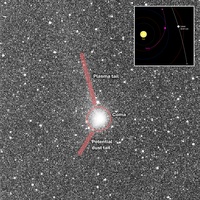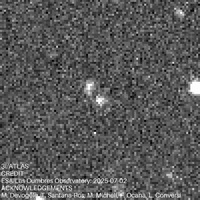Welcome to COBS!
Comet Observation database (COBS) saw first light in 2010 and is maintained by Crni Vrh Observatory. It is a free and unique service for comet observers worldwide which allows submission, display and analysis of comet data in a single location.
Amateur astronomers can make valuable contributions to comet science by observing comets and submitting their observations to COBS as professional astronomers typically do not have telescope time required to acquire regular observations. We therefore encourage comet observers worldwide to submit their observations and contribute to the COBS database.
Registered observers may submit observations using a web based form which stores the observations in an SQL database and stores them in ICQ format. Observations may be queried and plotted in the website or exported for further processing, analysis and publication. The database currently contains more than 297700 comet observations of more than 1720 different comets and represents the largest available database of comet observations.
The data stored in COBS is freely available to everyone who honors our data usage policy. Please cite COBS as the reference if you use it for comet studies.
Latest image
Comet C/2025 K1, obtained on 2025 December 10 (16h28-17h30UT) with 60-cm, f/7.0 Corrected Dall-Kirkham and ASI 2400 camera. Exposure time was 60x60 seconds. Image scale is 0.48 arc sec/pixel. Image was taken at Rezman observatory in Slovenia. Copyright © 2025 by R. Palcic, Rezman Observatory.
Comets visible today at Crni Vrh Observatory
| Comet | Mag | T | Source | Best time | Const | Obs | Chart | Comet PK | Comet MPC | Type | MPC name |
|---|
Location: Crni Vrh Observatory
Latitude: 45.94583; longitude: 14.07111; elevation: 726.0
Limiting mag: 15; Min altitude: 0; Min solar elong: 0; Min moon elong: 0
All times are in UTCComet finding charts provided by Dominic Ford: https://in-the-sky.org/
Lightcurve of comet C/2025 A6 (Lemmon)
Recent observations
| Type | Comet | Obs date | Meth | Mag | T | App | P | Dia | DC | Tail | Tail unit | PA | User | Pk |
|---|
Latest news
The Non-Gravitational Acceleration of 3I/ATLAS

XMM-Newton sees comet 3I/ATLAS in X-ray light

The European Space Agency’s X-ray space observatory XMM-Newton observed interstellar comet 3I/ATLAS on 3 December for around 20 hours. During that time, the comet was about 282–285 million km from the spacecraft.
Comet 3I/ATLAS shows activity in Juice navigation camera teaser

During November 2025, ESA’s Jupiter Icy Moons Explorer (Juice) used five of its science instruments to observe 3I/ATLAS. The instruments collected information about how the comet is behaving and what it is made of.
ESA pinpoints 3I/ATLAS’s path with data from Mars

Since comet 3I/ATLAS, the third known interstellar object, was discovered on 1 July 2025, astronomers worldwide have worked to predict its trajectory. ESA has now improved the comet’s predicted location by a factor of 10, thanks to the innovative use of observation data from our ExoMars Trace Gas Orbiter (TGO) spacecraft orbiting Mars.
Comet 3I/ATLAS has sprouted an unusual tail

